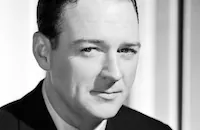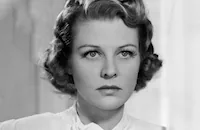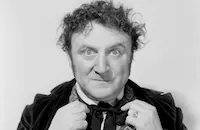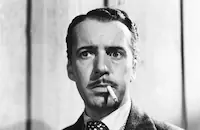The Blackmailer
Cast & Crew
Gordon Wiles
William Gargan
Florence Rice
H. B. Warner
Nana Bryant
George Mckay
Film Details
Technical Specs

Synopsis
Peter Cornish is the fast-talking beau of Jean Rankin, whose young stepmother Lydia is being blackmailed by Jack Donovan. Donovan has extorted enormous sums of money from Lydia, who wants to prevent him from revealing a romantic episode from her single days. After Donovan loses a bet on a horse in the Santa Anita Handicap, he telephones Lydia's suspicious husband Michael for an invitation to dinner. Donovan abruptly discards his girl friend, and as he drives off, she jumps up on the dashboard and is killed in an automobile accident. At the Rankin dinner, while the lights are turned out so that Donovan can demonstrate his "glow-in-the-dark" ring, he is murdered. The idiotic Inspector Killian arrives to solve the case, accompanied by an only slightly less foolish sergeant, who is also a writer. While Peter's suggestions guide Killian's investigation, Rosenkrantz, the new coroner, is terrified of the corpse. Reporters arrive at the Rankin house, and during Killian's questioning, Michael stands by his wife. During a re-enactment of the crime, another man is killed, and later a letter is found from "Ginger" in which Donovan's life is threatened. Jean and Peter flee the suspicious Killian and become lost among the other couples on Flirtation Lane. At the morgue, Peter notices that the girl killed in the accident, Caroline Holmes, had ginger-colored hair. Peter and Jean return to re-enact the crime a second time, and Peter makes himself the target. When the lights go on, he is wrestling with Nelson, the butler, who was Caroline's father. With the murder solved, Peter and Jean return to Flirtation Lane.

Director
Gordon Wiles
Cast

William Gargan

Florence Rice

H. B. Warner

Nana Bryant

George Mckay
Wyrley Birch
Drue Leyton
Paul Hurst

John Gallaudet
Victor Kilian

Herman Bing
Kenneth Thomson

Boyd Irwin Sr.
Alexander Cross

Joan Perry
Beatrice Blinn
Beatrice Curtis
Mary Lou Dix
Gene Morgan
Martha Tibbetts
Arthur Rankin
James T. Mack
Marc Lawrence
Chuck Hamilton
Kernan Cripps
Stanley Mack
Will Stanton
Lee Shumway
Raymond Turner
George Hickman
John Tyrrell
C. L. Sherwood
Sidney D'albrook
Eddie Fetherston
Nick Copeland
Harry Bernard
Crew

Film Details
Technical Specs

Articles
Marc Lawrence (1910-2005)
Born Max Goldsmith on February 17, 1910, in the Bronx, Lawrence had his heart set on a career in drama right out of high school. He enrolled at City College of New York to study theatre, and in 1930, he worked under famed stage actress Eva Le Gallienne. Anxious for a career in movies, Lawrence moved to Hollywood in 1932 and found work immediately as a contract player with Warner Bros. (an ideal studio for the actor since they specialized in crime dramas). He was cast as a heavy in his first film, If I Had a Million (1932). Although his first few parts were uncredited, Lawrence's roles grew more prominent: a sinister henchman in the Paul Muni vehicle in Dr. Socrates (1935); a conniving convict aiding Pat O'Brien in San Quentin (1937); a menacing thug stalking Dorothy Lamour in Johnny Apollo (1940); the shrewdly observant chauffeur in Alan Ladd's breakthrough hit This Gun For Hire (1942); and one of his most memorable roles as Ziggy, a fedora wearing mobster in the Bogart-Bacall noir classic Key Largo (1948).
Lawrence, when given the opportunity, could play against type: as the prosecuting attorney challenging Tyrone Power in Brigham Young (1940); a noble aristocrat in the Greer Garson-Walter Pidgeon period opus Blossoms in the Dust; and most impressively, as a deaf mute simpleton in the rustic drama The Shepherd of the Hills (both 1941). Better still was Lawrence's skill at comedy, where his deadpan toughness worked terrifically as a straight man against the likes of Joe E. Brown in Beware Spooks (1939); Abbott and Costello in Hit the Ice (1943); Penny Singleton in Life with Blondie (1945); and Bob Hope in My Favorite Spy (1951).
After that, Lawrence's career took a turn downward spin when he was labeled a communist sympathizer during the Hollywood witch hunts of the early '50s. He was exiled in Europe for a spell (1951-59), and when he came back, the film industry turned a blind eye to him, but television overcompensated for that. Here he played effective villains (what else?) in a series of crime caper programs: Peter Gunn, Johnny Staccato, The Untouchables, Richard Diamond, Private Detective; and eventually made a welcome return to the big screen as a returning exiled gangster in William Asher's underrated mob thriller Johnny Cool (1963).
It wasn't long before Lawrence found himself back in the fray playing in some big box-office hits over the next two decades: Diamonds Are Forever (1971), The Man with the Golden Gun (1974), Marathon Man (1976), Foul Play (1978); and The Big Easy (1987). Sure he was cast as a gangster, but nobody could play a rough and tumble mob boss with more style or conviction.
Interestingly, one of his finest performances in recent years was in television, as a severely ill old man unwilling to accept his fate in a fourth season episode of ER (1997-98). His last screen role was just two years ago, as a nimble minded VP in Looney Tunes: Back in Action (2003).
In 1991, Lawrence published a memoir about his venerable career, Long Time No See: Confessions of a Hollywood Gangster that received much critical acclaim. He has also developed a cult following due to his appearances in such offbeat items as From Dusk to Dawn and Pigs aka Daddy's Deadly Darling, the 1972 horror film he directed and starred in with his daughter Toni. He is survived by his wife, Alicia; two children from a previous marriage, Toni and Michael; and a stepdaughter Marina.
by Michael T. Toole

Marc Lawrence (1910-2005)
Quotes
Trivia
Notes
The Variety review commented on how the film changes from a mystery melodrama to a comedy and speculates that the sudden shift was the result of censorship. According to Variety, the exhibitors were advised to overlook the pressbook and sell the entire film as a farce.














